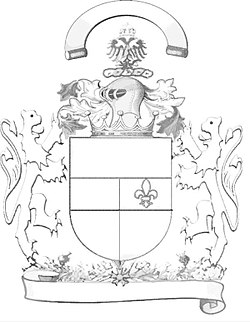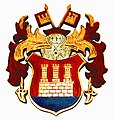Coat of arms

For upper arms counts heraldist the parts that are not the actual blazon include and are mounted on this or float.
Elements of the coat of arms
The upper coat of arms is generally built from the helmet . Helmet beads or crowns of leaves , helmet cushions and other helmet details are placed on the helmet . The symbols attached to the heraldic helmet, the helmet decorations , are taken from all areas of nature and art or the world of fables. Animal figures, flags, people and umbrella boards can be found in the upper coat of arms. Often only parts such as the front part or only the head are used in the animal figures. Furthermore, horns, wings ( flight ), feathers are popular. The helmet cover belongs to the helmet .
Some authors also count the rank crowns , which are crowns , helmets or hats , which are placed on the nobility rank according to the coat of arms and can replace the helmet, to the upper coat of arms. Others consider them to be secondary parts , and crowns can also belong to the helmet itself.
The elements shown in the shield are often repeated in the upper coat of arms. With the tinging (coloring) it is accordingly.
The English heraldry simplifies the upper coat of arms through the use of the crest .
Lords of Riedhausen : Upper coat of arms with the silver fish in the
Zurich coat of arms roll , around 1340Austria under Habsburg : The shield of Austria, a pot helmet with a peacock bump of the Habsburgs and a helmet cover in red and silver, like the Scheibler coat of arms , 15th / 16th century.
Kingdom of Bohemia
Ströhl , 1890
history
The upper coat of arms has developed into an art over time and, together with the coat of arms, shield holders and other attributes, forms the complete representation of the coat of arms. The upper coat of arms comes from the coat of arms show , where not only the battle shields but also the symbols of the knights' helmets were examined. Since the High Middle Ages, the coat of arms has also been listed in heraldic books and scrolls .
While the coat of arms mostly shows the territory, the upper coat of arms originally primarily shows the emblems of the family and the person, later to fiefdoms . Today the upper coat of arms contains all possible insignia of the coat of arms leader, whether person or institution.
Upper coat of arms with several helmets

Several helmets can be found in the genealogical coats of arms, especially in the marriage coats of arms : Here, if the two spouses are not represented in separate shields, the shields are united (according to the national rules, in German heraldry generally by splitting ) and the helmets the male and female family both set over the shield. In the course of the genealogy, several helmets can come together.
A sequence must be followed in blazon if there is more than one helmet over the coat of arms. For example, two helmets start with the heraldic right side. If there are three helmets above the coat of arms, the middle one is emblazoned first, then the heraldic right and finally the left helmet with its blankets and crest (2-1-3). If the number of helmets is greater than three, it is important whether there is an even or odd number of helmets. If there is an even number of helmets, the description starts in the middle and alternates left and right (5-3-1-2-4-6). The odd number of helmets is also started in the middle, but now started on the right and then switched to the left again the helmet decorations are described (6-4-2-1-3-5-7). If the number of helmets is unclear, start on the right. There are also blazons that extensively mention the middle helmet first, then one side and finally the other side. It is not mandatory to report the type of helmet, since middle-class families wear the uncrowned stech helmet and noble families wear the crowned spangenhelm .
Examples
rising lion
men's arms clad with slit puffed sleeves, holding two pointed stag poles
Red and gold helmet covers and helmet with two flags as (helmet decoration)
Individual evidence
- ↑ Gert Oswald : Lexicon of Heraldry . VEB Bibliographisches Institut, Leipzig 1984, p. 288 .
- ^ Bernhard Peter: Correct blazon. In: Introduction to Heraldry. Retrieved June 29, 2009 ( Order of Address section ).







